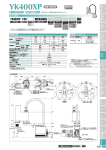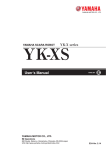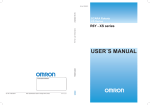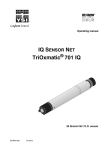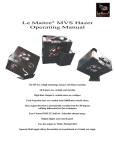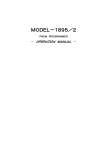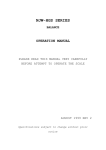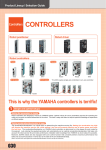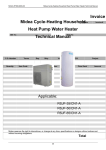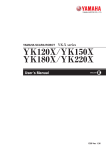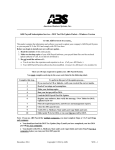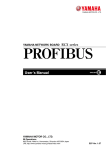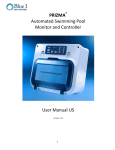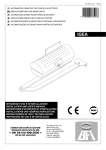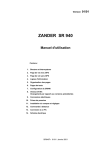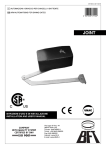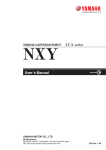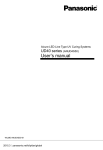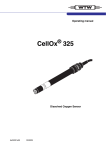Download warning - Yamaha Robotics
Transcript
YAMAHA SCARA ROBOT YK-X series YK-XP User’s Manual ENGLISH E E23-Ver. 2.04 Introduction This user’s manual was prepared for YK-XP series dust/drip proof models (YK250XP to YK1000XP) of the YAMAHA industrial robots. This user’s manual describes the safety measures, handling, adjustment and maintenance of YK-XP series robots for correct, safe and effective use. Be sure to read this manual carefully before installing the robot. Even after you have read this manual, keep it in a safe and convenient place for future reference. This user’s manual should be used with the robot and considered an integral part of it. When the robot is moved, transferred or sold, send this manual to the new user along with the robot. Be sure to explain to the new user the need to read through this manual. For the operating or maintenance procedures not described in this manual, please refer to the description of standard models listed in the "YAMAHA SCARA Robot YK-X/XH User's Manual". Also refer to that manual for precautions and warranty. If there are any obscure points in handling the robot, be sure to contact YAMAHA sales office or dealer. For details on specific operation and programming of the robot, refer to the separate “YAMAHA Robot Controller User’s Manual”. Always use air purge. Water or dust may get inside the robot depending on the usage environment. NOTES • The contents of this manual are subject to change without prior notice. • Information furnished by YAMAHA in this manual is believed to be reliable. However, if you find any part unclear or inaccurate in this manual, please contact YAMAHA sales office or dealer. YAMAHA MOTOR CO., LTD. IM Operations MEMO CONTENTS CHAPTER 1 Using the Robot Safely 1 Safety Information ..................................................... 1-1 2 Essential Caution Items ............................................ 1-2 3 Special Training for Industrial Robot Operation ........ 1-8 4 Robot Safety Functions ............................................. 1-9 5 Safety Measures for the System ............................. 1-10 6 Trial Operation......................................................... 1-11 7 Work Within the Safeguard Enclosure .................... 1-12 8 Automatic Operation ............................................... 1-13 9 Adjustment and Inspection ...................................... 1-13 10 Repair and Modification .......................................... 1-13 11 Warranty .................................................................. 1-14 12 CE Marking ............................................................. 1-16 CHAPTER 2 Functions 1 Robot Manipulator ..................................................... 2-1 CHAPTER 3 Installation 1 Robot Installation Conditions .................................... 3-1 1-1 Protection rating for moisture and dust on dust/drip proof models .... 3-1 2 User Wiring Connectors and User Tubing ................. 3-2 3 Air Purge Tubing ....................................................... 3-6 4 Exhaust Port .............................................................. 3-7 CHAPTER 4 Adjustment 1 Removing the Robot Covers ..................................... 4-1 1-1 1-2 1-3 Removing the Y-axis arm upper cover (YK250XP to YK400XP) ....... 4-2 Removing the Y-axis arm upper cover (YK500XP, YK600XP) ........... 4-6 Removing the Y-axis arm upper cover (YK700XP to YK1000XP) ... 4-10 2 Origin Position Stickers ........................................... 4-14 3 Adjusting the Z-axis Machine Reference ................ 4-15 CHAPTER 5 Specifications 1 Robot Manipulator ..................................................... 5-1 1-1 Basic specifications ............................................................................ 5-1 CHAPTER 1 Using the Robot Safely 1 Safety Information ........................................................... 1-1 2 Essential Caution Items ................................................... 1-2 3 Special Training for Industrial Robot Operation ............... 1-8 4 Robot Safety Functions ................................................... 1-9 5 Safety Measures for the System ................................... 1-10 6 Trial Operation ................................................................ 1-11 7 Work Within the Safeguard Enclosure ........................... 1-12 8 Automatic Operation ...................................................... 1-13 9 Adjustment and Inspection ............................................ 1-13 10 Repair and Modification ................................................. 1-13 11 Warranty ........................................................................ 1-14 12 CE Marking .................................................................... 1-16 MEMO CHAPTER 1 Using the Robot Safely 1 Safety Information Industrial robots are highly programmable, mechanical devices that provide a large degree of freedom when performing various manipulative tasks. To ensure correct and safe use of YAMAHA industrial robots, carefully read this manual and make yourself well acquainted with the contents. FOLLOW THE WARNINGS, CAUTIONS AND INSTRUCTIONS INCLUDED IN THIS MANUAL. Failure to take necessary safety measures or mishandling due to not following the instructions in this manual may result in trouble or damage to the robot and injury to personnel (robot operator or service personnel) including fatal accidents. Warning information in this manual is shown classified into the following items. DANGER Failure to follow DANGER instructions will result in severe injury or death to the robot operator, a bystander or a person inspecting or repairing the robot. WARNING Failure to follow WARNING instructions could result in severe injury or death to the robot operator, a bystander or a person inspecting or repairing the robot. ! CAUTION Failure to follow CAUTION instructions may result in injury to the robot operator, a bystander or a person inspecting or repairing the robot, or damage to the robot and/or robot controller. NOTE Explains the key point in the operation in a simple and clear manner. Refer to the instruction manual by any of the following methods to operate or adjust the robot safely and correctly. 1. Operate or adjust the robot while referring to the printed version of the instruction manual (available for an additional fee). 2. Operate or adjust the robot while viewing the CD-ROM version of the instruction manual on your computer screen. 3. Operate or adjust the robot while referring to a printout of the necessary pages from the CD-ROM version of the instruction manual. It is not possible to detail all safety items within the limited space of this manual. So it is essential that the user have a full knowledge of basic safety rules and also that the operator makes correct judgments on safety procedures during operation. This manual and warning labels supplied with or affixed to the robot are written in English. If the robot operator or service personnel does not understand English, do not permit him to handle the robot. 1-1 CHAPTER 1 Using the Robot Safely 2 Essential Caution Items Particularly important cautions for handling or operating the robot are described below. In addition, safety information about installation, operation, inspection and maintenance is provided in each chapter. Be sure to comply with these instructions to ensure safe use of the robot. (1) Observe the following cautions during automatic operation. Warning labels 1 (Fig. 1-1) are affixed to the robot. See Fig. 2-1 and Fig. 2-2 for the locations of warning labels. • Install a safeguard enclosure (protective enclosure) to keep any person from entering within the movement range of the robot and suffering injury due to being struck by moving parts. • Install a safety interlock that triggers emergency stop when the door or panel is opened. • Install safeguards so that no one can enter inside except from doors or panels equipped with safety interlocks. • The warning labels shown in Fig. 1-1 are supplied with the robot and should be affixed to a conspicuous spot on doors or panels equipped with safety interlocks. DANGER Serious injury or death will result from impact with moving robot. • Keep outside of guard during operation. • Lock out power before approaching robot. (2) Use caution to prevent hands or fingers from being pinched or crushed. Warning labels 2 (Fig. 1-2) are affixed to the robot. See Fig. 2-1 and Fig. 2-2 for the locations of warning labels. Be careful not to let hands or fingers be pinched or crushed by the moving parts of the robot during transportation or teaching. WARNING Moving parts can pinch or crush. Keep hands away from robot arms. DANGER WARNING Serious injury or death will result from impact with moving robot. • Keep outside of guard during operation. • Lock out power before approaching robot. ■Fig. 1-1 Warning label 1 1-2 Moving parts can pinch or crush. Keep hands away from robot arms. ■Fig. 1-2 Warning label 2 CHAPTER 1 Using the Robot Safely (3) Follow the instructions on warning labels and in this manual. Warning label 3 (Fig. 1-3) is affixed to the robot. See Fig. 2-1 and Fig. 2-2 for the locations of warning labels. • Be sure to read the warning label and this manual carefully and make your thoroughly understand the contents before attempting installation and operation of the robot. • Before starting the robot operation, even after you have read through this manual, read again the corresponding procedures and cautions in this manual as well as descriptions in the this chapter (Chapter 1, "Using the Robot Safely"). • Never install, adjust, inspect or service the robot in any manner that does not comply with the instructions in this manual. WARNING Improper installation or operation can result in serious injury or death. Read user's manual and all warning labels before operation. WARNING Improper Installation or operation can result in serious injury or death. Read user's(owner's) manual and all warning labels before operation. ■Fig. 1-3 Warning label 3 (4) Do not use the robot in environments containing inflammable gas, etc. WARNING • This robot was not designed for operation in environments where inflammable or explosive substances are present. • Do not use the robot in environments containing inflammable gas, dust or liquids. Explosions or fire could otherwise result. (5) Do not use the robot in locations possibly subject to electromagnetic interference, etc. WARNING Avoid using the robot in locations subject to electromagnetic interference, electrostatic discharge or radio frequency interference. Malfunction may otherwise occur. 1-3 CHAPTER 1 Using the Robot Safely (6) Use caution when releasing the Z-axis (vertical axis) brake. WARNING The Z-axis will slide down when the Z-axis brake is released, causing a hazardous situation. • Press the emergency stop button and prop up the Z-axis with a support stand before releasing the brake. • Use caution not to let your body get caught between the Z-axis and installation base when releasing the brake to perform direct teach. (7) Provide safety measures for end effector (gripper, etc.). WARNING • End effectors must be designed and manufactured so that they cause no hazards (for example, loosening of workpiece) even if power (electricity, air pressure, etc.) is shut off or power fluctuations occur. • If there is a possible danger that the object gripped by the end effector may fly off or drop, then provide appropriate safety protection taking into account the object size, weight, temperature and chemical properties. (8) Be cautious of possible Z-axis movement when the controller is turned off or emergency stop is triggered. (2-axis robots with air-driven Z-axis) WARNING The Z-axis moves up when the power to the controller or PLC is turned off, the program is reset, emergency stop is triggered, or air is supplied to the solenoid valve for the Z-axis air cylinder. • Do not let hands or fingers get caught and squeezed by moving parts of the Z-axis. • Keep the usual robot position in mind so that the Z-axis will not interfere with obstacles during raising of the Z-axis, except in case of emergency stop. (9) Use the following caution items when the Z-axis is interfering with peripheral equipment. (2-axis robots with air driven Z-axis) WARNING When the Z-axis comes to a stop due to obstructions from peripheral equipment, the Z-axis may move suddenly when the obstruction is removed, causing injury such as pinched or crushed hands. • Turn off the controller and reduce the air pressure before attempting to remove the obstruction. • Before reducing the air pressure, place a support stand under the Z-axis because it will drop under its own weight. 1-4 CHAPTER 1 Using the Robot Safely (10) Use caution on Z-axis movement when air supply is stopped. (2axis robots with air-driven Z-axis) WARNING The Z-axis may suddenly drop when the air pressure to the Z-axis air cylinder solenoid valve is reduced, creating a hazardous situation. Turn off the controller and place a prop or support under the Z-axis before cutting off the air supply. (11) Use the following caution items when disassembling or replacing the pneumatic equipment. WARNING Air or parts may fly outwards if pneumatic equipment is disassembled or parts replaced while air is still supplied. • Do service work after first turning off the controller and reducing the air pressure. • Before reducing the air pressure, place a support stand under the Z-axis (2axis robots with air driven Z-axis) since it will drop under its own weight. (12) Use the following caution items when removing the Z-axis motor. WARNING The Z-axis will drop when the Z-axis motor is removed, possibly resulting in injury. • Turn off the controller and set a support stand under the Z-axis before removing the motor. • Use caution not to allow hands or body to be squeezed or crushed by moving parts on the Z-axis or between the Z-axis and the installation base. (13) Use the following caution during inspection of controller. WARNING • When you need to touch the terminals or connectors on the outside of the controller during inspection, always first turn off the controller power switch and also the power source in order to prevent possible electrical shock. • Never touch any internal parts of the controller. For precautions on handling the controller, refer to the "YAMAHA Robot Controller User's Manual". 1-5 CHAPTER 1 Using the Robot Safely (14) Consult us for corrective action when the robot is damaged or malfunction occurs. WARNING If any part of the robot is damaged or any malfunction occurs, continuous operation may be very dangerous. Please consult YAMAHA dealer for corrective action. Damage or Trouble Possible Danger Damage to machine harness or robot cable Electrical shock, malfunction of robot Damage to exterior of robot Flying outwards of damaged parts during robot operation Abnormal operation of robot (positioning error, excessive vibration, etc.) Malfunction of robot Z-axis brake trouble Dropping of load (15) Use caution not to touch the X-axis motor cooling fan (YK550X) and controller rear panel cooling fan. WARNING • Bodily injury may occur from coming into contact with the cooling fan while it is rotating. • When removing the fan cover for inspection, first turn off the controller and make sure the fan has stopped. (16) Use caution not to touch the high temperature motor or speed reduction gear casing. WARNING The motor and speed reduction gear casing are extremely hot after automatic operation, so burns may occur if these are touched. Before touching these parts during inspections or servicing, turn off the controller, wait for a while and check that the temperature has cooled. (17) Do not remove, alter or stain the warning labels. WARNING If warning labels are removed or difficult to see, necessary cautions may not be taken, resulting in an accident. • Do not remove, alter or stain the warning labels on the robot. • Do not allow the warning labels to be hidden by the device installed to the robot by the user. • Provide proper lighting so that the symbols and instructions on the warning labels can be clearly seen even from the outside of safeguards. 1-6 CHAPTER 1 Using the Robot Safely (18) Protective bonding WARNING Be sure to ground the robot and controller to prevent electrical shock. (19) Do not allow any object to enter the X-axis motor cooling fan. (See Fig. 2-6 of the YK-X/XH user's manual.) WARNING If an object such as a small workpiece which the end effector failed to pick up, penetrates into the cooling fan for the X-axis motor, it may rebound and fly away from the fan, possibly causing bodily injury or damage to the fan. • Provide a proper protective wall which prevents workpieces or other objects from entering the fan. • When providing a protective wall, allow a space of at least 100mm between the fan vent and the wall to ensure air flow and cooling effects. (20) Be sure to make correct parameter settings. ! CAUTION The robot must be operated with correct tolerable moment of inertia and acceleration coefficients according to the manipulator tip mass and moment of inertia. If this is not observed, premature end to the life of the drive units, damage to the robot parts or residual vibration during positioning may result. (21) Do not use the robot for tasks requiring motor thrust. ! CAUTION Avoid using the YK-X series robots for tasks which make use of motor thrust (press-fitting, burr removal, etc.). These tasks may cause malfunctions of the robot. (22) If the X, Y or R axis rotation angle is small ! CAUTION If the X, Y or R axis rotation angle is smaller than 5° so that it always moves in the same position, an oil film is difficult to be formed on the joint support bearing, possibly leading to damage to the bearing. In this type of operation, add a movement so that the joint moves through 90° or more, about 5 times a day. 1-7 CHAPTER 1 Using the Robot Safely 3 Special Training for Industrial Robot Operation Companies or factories using industrial robots must make sure that every person, who handles the robot such as for teaching, programming, movement check, inspection, adjustment and repair, has received appropriate training and also has the skills needed to perform the job correctly and safely. Since the YK-X series robots fall under the industrial robot category, the user must observe local regulations and safety standards for industrial robots, and provide special training for every person involved in robot-related tasks (teaching, programming, movement check, inspection, adjustment, repair, etc.). 1-8 CHAPTER 1 Using the Robot Safely 4 Robot Safety Functions (1) Overload detection This function detects an overload applied to the motor and shuts off the servo power. If an overload error occurs, take the following measures. 1. Insert a timer in the program. 2. Reduce the acceleration coefficient. (2) Overheat detection This function detects an abnormal temperature rise in the driver inside the controller and shuts off the servo power. If an overheat error occurs, take the following measures. 1. Insert a timer in the program. 2. Reduce the acceleration coefficient. (3) Soft limits Soft limits can be set on each axis to limit the working envelope in manual operation after return-to-origin and during automatic operation. Note: The working envelope is the area limited by soft limits. (4) Mechanical stoppers If the servo power is suddenly shut off during high-speed operation by emergency stop or safety functions, these mechanical stoppers prevent the axis from exceeding the movement range. The movement ranges of the X-axis arm can be limited as needed by use of mechanical stoppers. (Excluding the YK250X(H), YK350X(H) and YK400X(H)) On the Y-axis arm, mechanical stoppers are fixed at both ends of the maximum movement range. The Z-axis has a mechanical stopper at the upper end and lower end. No mechanical stopper is provided on the R-axis. Note: The movement range is the area limited by mechanical stoppers. WARNING Axis movement will not stop immediately after the servo power supply is shut off by emergency stop or other safety functions. (5) Z-axis (vertical axis) brake An electromagnetic brake is installed on the Z-axis to prevent the Z-axis from sliding down when servo power is turned off. This brake is working when the controller is off or the Z-axis servo power is off even when the controller is on. The Z-axis brake can be released by means of the programming unit or by a command in the program when the controller is on. WARNING The Z-axis will slide down when the Z-axis brake is released, creating a hazardous situation. • Press the emergency stop button and prop the Z-axis with a support stand before releasing the brake. • Use caution not to let your body get caught between the Z-axis and installation base when releasing the brake to perform direct teach. 1-9 CHAPTER 1 Using the Robot Safely 5 Safety Measures for the System Since the robot is commonly used in conjunction with an automated system, dangerous situations are more likely to occur from the automated system than from the robot itself. Accordingly, appropriate safety measures must be taken on the part of the system manufacturer according to the individual system. The system manufacturer should provide a proper instruction manual for safe, correct operation and servicing of the system. 1-10 CHAPTER 1 Using the Robot Safely 6 Trial Operation After making installations, adjustments, inspections, maintenance or repairs to the robot, make a trial run using the following procedures. (1) If a safeguard enclosure has not yet been provided right after installation of the robot, rope off or chain off around the movement area of the manipulator in place of the safeguard enclosure, and observe the following points. 1. Use sturdy, stable posts which will not fall over easily. 2. The rope or chain should be easily visible by everyone around the robot. 3. Place a sign to keep the operator or other personnel from entering the movement range of the manipulator. (2) Check the following points before turning on the controller. 1. Is the robot securely and correctly installed? 2. Are the electrical connections to the robot correct? 3. Are items such as air pressure correctly supplied? 4. Is the robot correctly connected to peripheral equipment? 5. Have safety measures (safeguard enclosure, etc.) been taken? 6. Does the installation environment meet the specified standards. (3) After the controller is turned on, check the following points from outside the safeguard enclosure. 1. Does the robot start and stop as intended? Can the operation mode be selected correctly? 2. Does each axis move as intended within the soft limits? 3. Does the end effector move as intended? 4. Are the signal transmissions to the end effector and peripheral equipment correct? 5. Does emergency stop work? 6. Are the teaching and playback functions normal? 7. Are the safeguard enclosure and interlock working as intended? 8. Does the robot move correctly during automatic operation? 1-11 CHAPTER 1 Using the Robot Safely 7 Work Within the Safeguard Enclosure (1) When work is required inside the safeguard enclosure, always turn off the controller and place a sign indicating that the robot is being adjusted or serviced in order to keep any other person from touching the controller switch or operation panel, except for the following cases. 1) Origin position setting (See Section 3 in Chapter 4.) 2) Soft limit settings (See Section 4 in Chapter 4.) 3) Standard coordinate settings (See Section 5 in Chapter 4.) 4) Inspection of the X-axis motor cooling fan inside the base (YK550X only) (See (2) of Section 4 in Chapter 5.) 5) Teaching For items 1) to 4), follow the precautions and procedure for each section. To perform item 5), refer to the description in (2) below. (2) Teaching When performing teaching within the safeguard enclosure, comply with the instructions listed below. 1) Check or perform the following points from outside the safeguard enclosure. 1. Make sure that no hazards are present within the safeguard enclosure by a visual check. 2. Check that the programming unit MPB operates correctly. 3. Check that no failures are found in the robot. 4. Check that emergency stop works correctly. 5. Select teaching mode and prohibit automatic operation. 2) Never enter the movement range of the manipulator while within the safeguard enclosure. 1-12 CHAPTER 1 Using the Robot Safely 8 Automatic Operation Automatic operation described here includes all operations in AUTO mode. (1) Check the following before starting automatic operation. 1. No one is within the safeguard enclosure. 2. The programming unit and tools are in their specified locations. 3. The alarm or error lamps on the robot and peripheral equipment do not flash. 4. The safeguard enclosure is securely installed with safety interlocks actuated. (2) Observe the following during automatic operation or in cases where an error occurs. 1) After automatic operation has started, check the operation status and warning lamp to ensure that the robot is in automatic operation. 2) Never enter the safeguard enclosure during automatic operation. 3) If an error occurs in the robot or peripheral equipment, observe the following procedure before entering the safeguard enclosure. 1. Press the emergency stop button to set the robot to emergency stop. 2. Place a sign on the start switch, indicating that the robot is being inspected in order to keep any other person from touching the start switch and restarting the robot. 9 Adjustment and Inspection Do not attempt any installation, adjustment, inspection or maintenance unless it is described in this manual. 10 Repair and Modification Do not attempt any repair, parts replacement and modification unless described in this manual. These works require technical knowledge and skill, and may also involve work hazards. 1-13 CHAPTER 1 Using the Robot Safely 11 Warranty The YAMAHA robot and/or related product you have purchased are warranted against the defects or malfunctions as described below. Warranty description : If a failure or breakdown occurs due to defects in materials or workmanship in the genuine parts constituting this YAMAHA robot and/or related product within the warranty period, then YAMAHA will repair or replace those parts free of charge (hereafter called "warranty repair"). Warranty Period : The warranty period ends when any of the following applies: (1) After 18 months (one and a half year) have elapsed from the date of shipment (2) After one year has elapsed from the date of installation (3) After 2,400 hours of operation Exceptions to the Warranty : This warranty will not apply in the following cases: (1) Fatigue arising due to the passage of time, natural wear and tear occurring during operation (natural fading of painted or plated surfaces, deterioration of parts subject to wear, etc.) (2) Minor natural phenomena that do not affect the capabilities of the robot and/or related product (noise from computers, motors, etc.). (3) Programs, point data and other internal data that were changed or created by the user. Failures resulting from the following causes are not covered by warranty repair. 1) Damage due to earthquakes, storms, floods, thunderbolt, fire or any other natural or man-made disasters. 2) Troubles caused by procedures prohibited in this manual. 3) Modifications to the robot and/or related product not approved by YAMAHA or YAMAHA sales representatives. 4) Use of any other than genuine parts and specified grease and lubricants. 5) Incorrect or inadequate maintenance and inspection. 6) Repairs by other than authorized dealers. 1-14 CHAPTER 1 Using the Robot Safely YAMAHA MOTOR CO., LTD. MAKES NO OTHER EXPRESS OR IMPLIED WARRANTIES, INCLUDING ANY IMPLIED WARRANTY OF MERCHANTABILITY OR FITNESS FOR ANY PARTICULAR PURPOSE. THE WARRANTY SET FORTH ABOVE IS EXCLUSIVE AND IS IN LIEU OF ALL EXPRESSED OR IMPLIED WARRANTIES, INCLUDING WARRANTIES OF MERCHANTABILITY, FITNESS FOR A PARTICULAR PURPOSE, OR WARRANTIES ARISING FROM A COURSE OF DEALING OR USAGE OF TRADE. YAMAHA MOTOR CO., LTD. SOLE LIABILITY SHALL BE FOR THE DELIVERY OF THE EQUIPMENT AND YAMAHA MOTOR CO., LTD. SHALL NOT BE LIABLE FOR ANY CONSEQUENTIAL DAMAGES (WHETHER ARISING FROM CONTRACT, WARRANTY, NEGLIGENCE OR STRICT LIABILITY). YAMAHA MOTOR CO., LTD. MAKES NO WARRANTY WHATSOEVER WITH REGARD TO ACCESSORIES OR PARTS NOT SUPPLIED BY YAMAHA MOTOR CO., LTD. 1-15 CHAPTER 1 Using the Robot Safely 12 CE Marking When the YAMAHA robots are exported to or used in EU (European Union) countries, refer to the separate "YAMAHA Robot Controller User's Manual" or "CE marking Supplement Manual" for related information about CE marking. 1-16 CHAPTER 2 Functions 1 Robot Manipulator ........................................................... 2-1 MEMO CHAPTER 2 Functions 1 Robot Manipulator Figs.2-1 and 2-2 below show the part names and functions of the YK-XP series robots. User tubing 1 (φ4 black) User tubing 2 (φ4 red) User tubing 3 (φ4 blue) Connector for user wiring (pins 1 to 10) Connector for user wiring (pins 1 to 10) Serial number label Exhaust port (6-φ12) Ball screw machine harness X-axis joint air purge port (φ6) Y-axis joint air purge port (φ6) R-axis joint air purge port (φ6) Warning label 1 Warning label 2 Z-axis motor User tubing 1 (φ4 black) User tubing 2 (φ4 red) User tubing 3 (φ4 blue) R-axis motor Z-axis, R-axis pulley, belt Y-axis motor Robot cable Y-axis arm M4 ground terminal Y-axis speed reduction gear Y-axis mechanical stopper R-axis speed reduction gear * Always use air purge. Water or dust may get inside depending on usage environment. Bellows End effector attachment X-axis arm X-axis mechanical stopper X-axis speed reduction gear Warning label 3 X-axis motor Fig. 2-1 YK250XP to YK400XP dust/drip proof robots 2-1 CHAPTER 2 Functions Connector for user wiring (pins.1 to 20) Eyebolt installation position User tubing 1 (φ6 black) Y-axis mechanical stopper User tubing 2 (φ6 red) User tubing 3(φ6 blue) X-axis movable mechanical stopper Machine harness Ball screw Warning label 1 (Same on opposite side) Warning label 2 (Same on opposite side) Y-axis motor R-axis motor Z-axis,R-axis pulley, belt Z-axis motor Y-axis speed reduction gear R-axis speed reduction gear Bellows X-axis arm End effector attachment X-axis speed reduction gear X-axis motor Warning label 3 M4 ground terminal Serial label User tubing 1 (φ6 black) User tubing 2 (φ6 red) Robot cable User tubing 3 (φ6 blue) Connector for user wiring (No.1 to 20) X-axis joint air purge port (φ6) Y-axis joint air purge port (φ6) R-axis joint air purge port (φ6) * Always use air purge. Water or dust may get inside depending on usage environment. Fig. 2-2 YK500XP to YK1000XP dust/drip proof robots 2-2 CHAPTER 3 Installation 1 Robot Installation Conditions ........................................... 3-1 1-1 Protection rating for moisture and dust on dust/drip proof models .... 3-1 2 User Wiring Connectors and User Tubing ....................... 3-2 3 Air Purge Tubing .............................................................. 3-6 4 Exhaust Port .................................................................... 3-7 MEMO CHAPTER 3 Installation 1 Robot Installation Conditions Aside from moisture and dust conditions, the dust/drip proof model is identical to the standard specification model. 1-1 Protection rating for moisture and dust on dust/drip proof models The protection rating for moisture and dust in the YK-250XP through YK1000XP dust/drip proof models are equivalent to IP65. Please consult YAMAHA for dripproof specifications for other than water. Always use air purge. Water or dust may get inside depending on usage environment. IP 6 5 Degree of protection versus water penetration : 5 At level 5, water injected from an optional angle does not exert a harmful effect. Water injection pressure per the standards is 30kPa (30kN/m2, 0.3kgf/cm2) Injection speed is 12.5 liters per minute, at a time interval of 3 minutes. Water may penetrate inside the robot if the water pressure is higher than this level. Degree of protection versus solid debris : 6 At level 6 there is no dust penetration. WARNING Do not immerse and use the robot or any part of the robot in water. Water will otherwise penetrate inside the robot. WARNING Do not use the robot in environments exceeding the listed levels of protection for dust and moisture. Water or dust may otherwise penetrate inside the robot. 3-1 CHAPTER 3 Installation 2 User Wiring Connectors and User Tubing WARNING Wiring and tubing work may cause malfunctions so turn off the power to the controller and shut off the air supply. Only the user signal wiring for the YK-500XP through YK1000XP dust/drip proof models are different from the standard wiring. Other dust/drip proof model user signal wiring and air tubes are identical to the standard parts. 1) The number of signal wires for the YK-500XP to YK1000XP dust/drip proof models is as follows. Models User wires YK500XP, YK600XP, YK700XP, YK800XP, YK1000XP 20 wires User Wiring Rated voltage 30V Allowable current 1.5A Nominal cross-section area of conductor 0.2mm2 Shield Yes 2) Both the arm and the base (robot pedestal) have user wiring connectors and user tubing joints. For their locations, refer to the dimensional drawings listed in our robot catalog or our home page (www.yamaha-motor.co.jp/global/ industrial/robot/index.html). Attach the end caps and plugs (supplied) when the user wiring connectors and user tubing joints on the YK-250XP to YK1000XP dust/drip proof models are not used. Moisture and dust will penetrate inside if these end caps and plugs are not used. 3-2 CHAPTER 3 Installation 3) Signal wire connections in the machine harness Connector pins 1 through 23 can be used for user signal wires in the YK500XP, YK600XP, YK700XP, YK800XP, YK1000XP. The shield wire is connected to pin 24 and so it cannot be used as a signal wire. Signal Connector NO Connection NO Connector Color 1 1 Blue 2 2 Orange 3 3 Green 4 4 Brown 5 5 Grey 6 6 Red 7 7 Black 8 8 Yellow 9 9 Pink 10 10 Violet 11 11 IO 12 12 (Arm side) 13 13 14 14 Green/White 15 15 Brown/White 16 16 Grey/White 17 17 Red/White 18 18 Black/White 19 19 Yellow/Black 20 20 Pink/Black 24 24 User signal line Flame Ground 1 Flame Ground White IO Blue/Red (Base side) Orange/White Orange/White FG Green 4) Make wiring to the YK-250XP through YK1000XP connectors as follows. Solder the user signal wires to the connector as shown in Fig. 3-1 and assemble the connector. Then connect it to the user wiring connector. Tighten each connector screw to the specified torque. When the outer diameter of the cable is small, use tape or an equivalent item to make the section under the cable clamp fatter. Otherwise, moisture and dust will penetrate inside. Setscrew B User wiring Setscrew A ● Screw tightening torque Position Torque value (kgf • cm) End hood 10 to 15 Clamp nut 15 to 20 Setscrews A & B 2 to 3 Clamp nut Solder End hood Fig. 3-1 3-3 Model Cable outer diameter (mm) YK250XP to YK400XP φ13.1 to 15.0 YK500XP to YK1000XP φ16.1 to 18.0 CHAPTER 3 Installation WARNING The user cable wires should have a shield wire. Connect it to the same No. pin in the user wiring connector on the robot side, which also connects to the shield wire. If this task is omitted, noise may cause malfunction of the robot. WARNING Securely attach the connector (supplied with the robot) into the user wiring connector on the robot side, by tightening the screws on the connector hood. If this connector comes loose or comes off, malfunction may result. WARNING Avoid fastening the user cable or tube with the machine harness, as this may lead to harness breakage and malfunction. WARNING Make sure that the user cable attached to the user wiring connector and the user tubing joint will not interfere with the robot movement, entangle around the robot or flap around during operation. Wiring and tubing might then be damaged causing malfunction of the robot. WARNING Lay out the user cable attached to the user wiring connector and the user tubing coupling so that they do not obstruct the movement of the operator or any other persons. Bodily injury may result if anyone trips on the cable or air tube. ! CAUTION The connector supplied with the robot should be connected to the arm side by pin contact, and to the robot pedestal side by socket contact. Use caution at these points when soldering. 3-4 CHAPTER 3 Installation ! CAUTION Be sure to use the connector supplied with the robot. Using other types may result in contact failure. Robot model Connector on arm side Connector on base (pedestal) side YK250XP, YK350XP, YK400XP NJW-24-16-PM-15 NJW-24-16-PF-15 YK500XP, YK600XP, YK700XP, YK800XP, YK1000XP NJW-28-24-PM-18 NJW-28-24-PF-18 Manufacturer: Nanahoshi Science Laboratory 5) To check the operation and signal exchange between the end effector and the controller or peripheral equipment after making connections, refer to “6. Trial operation” of Chapter 1 in the YAMAHA SCARA robot YK-X/XH user’s manual. 3-5 CHAPTER 3 Installation 3 Air Purge Tubing WARNING Turn off power to the controller before doing piping or tubing work and shut off the air supply. The dust/drip proof models have air supply inlets in the base (pedestal) rear panel for air purge of X-axis, Y-axis and R-axis joints. Supplying air to these inlets prevents dust from penetrating into the robot joint. Specifications are as follows. Maximum pressure Outer diameter × Inner diameter 0.58MPa (6kgf • cm2) φ6mm×φ4mm Fluid Use pure dry air containing no deteriorated compressor oil or other elements. Filtration rate of air filter should be 40µm or less. Always use air purge. Water or dust may get inside the robot depending on the usage environment. Adjust the pressure and flow rate with the speed controllers on the rear of the base (pedestal) to keep water and dust from getting inside. See "1 Robot Manipulator" in Chapter 2 for the locations of the air purge ports. WARNING Install the air purge tubing so it will not become an obstruction that might cause injuries if people stumble on it and fall. ! CAUTION Install the air purge tubing so it will not obstruct robot movement. 3-6 CHAPTER 3 Installation 4 Exhaust Port WARNING Turn off power to the controller before doing piping or tubing work. ! CAUTION Before operating the robot, always be sure to remove the plug installed in the exhaust port prior to shipping. If not removed, the bellows will be unable to extend and retract and may be damaged. The dust/drip proof models have 6 air exhaust ports (12mm dia.) in the base (pedestal) rear panel. These provide an air passage for extending and retracting the Z-axis bellows. If these exhaust ports are blocked, the bellows cannot adequately extend or retract and may be damaged. Plugs are inserted in these exhaust ports before shipment so always be sure to remove them before operating the robot. If moisture or dust is entering from these exhaust ports, connect them to a 12mm diameter air tube extending to a location free of dust and moisture. WARNING Install the exhaust tubing so they will not become an obstruction that might cause injuries if people stumble on it and fall. ! CAUTION Install the exhaust tubing so they will not obstruct robot movement. 3-7 MEMO 3-8 CHAPTER 4 Adjustment 1 Removing the Robot Covers ........................................... 4-1 1-1 1-2 1-3 Removing the Y-axis arm upper cover (YK250XP to YK400XP) ....... 4-2 Removing the Y-axis arm upper cover (YK500XP, YK600XP) ........... 4-6 Removing the Y-axis arm upper cover (YK700XP to YK1000XP) ... 4-10 2 Origin Position Stickers ................................................. 4-14 3 Adjusting the Z-axis Machine Reference ....................... 4-15 MEMO CHAPTER 4 Adjustment 1 Removing the Robot Covers The following steps show the procedure for removing the robot cover. Follow these steps for maintenance work. 1) Prepare the necessary tools. • Hex wrench set • Phillips-head screwdriver 2) Turn off the controller. 3) Place a sign indicating the robot is being adjusted, to keep others from operating the controller switch. 4) Enter the safeguard enclosure. 5) Remove the covers while referring to Fig. 4-1 to Fig. 4-3. Screws used to fasten each cover are listed in Tables 4-1 to 4-3. 6) To remove the Y-axis upper cover, see the procedure explained in 1-1 to 1-3. Table 4-1 YK250XP, YK350XP, YK400XP (See Fig. 4-1) Screw No. Screw size Qty Base (pedestal) rear cover q M4×18 4 Base (pedestal) front cover w M4×12 4 Cover name Y-axis arm upper block e Y-axis arm side frame r M3×20 4 M3 seal washer M4×6 10 (YK250XP, YK350XP) 11 (YK400XP) Table 4-2 YK500XP, YK600XP (See Fig. 4-2) Cover name Screw No. Base (robot pedestal) rear cover 1 q Base (robot pedestal) front cover w Y-axis arm upper block e Y-axis arm side frame r Y-axis arm upper bearing holder Y-axis arm upper cover: bottom t y Base (robot pedestal) rear cover 2 u X-axis arm upper cover i Y-axis arm under cover o 4-1 Screw size M4×8 M4 seal washer M4×8 M3×25 M3 seal washer M4×8 M4 seal washer M4×10 M3×50 M3 seal washer M4×8 M4 seal washer M4×6 M4×10 M4 seal washer Qty 8 4 4 14 4 4 4 2 4 CHAPTER 4 Adjustment Table 4-3 YK700XP, YK800XP, YK1000XP (See Fig. 4-3) Cover name Base (robot pedestal) rear cover 1 q Base (robot pedestal) side cover w Y-axis arm upper block e Y-axis arm side frame r Y-axis arm upper bearing holder Y-axis arm upper cover: bottom 1-1 Screw No. t y Base (robot pedestal) rear cover 2 u X-axis arm upper cover i Y-axis arm under cover o Screw size Qty M4×8 8 M4 seal washer M4×8 8 M4×50 2 M4×30 2 M4×8 14 (YK700XP, YK800XP) M4 seal washer 16 (YK1000XP) M4×10 M3×50 M4 seal washer M4×8 M4 seal washer 4 4 4 M4×8 2 M4×10 4 (YK700XP, YK800XP) M4 seal washer 6 (YK1000XP) Removing the Y-axis arm upper cover (YK250XP to YK400XP) Proceed as follows while referring to Fig. 4-1. 1) Turn off the controller power. 2) Place a sign indicating “work in progress”, to keep others from operating the controller switch. 3) Remove the front cover and rear cover of the robot base (pedestal). 4) Remove the FG wire round terminals (2 pcs) from the machine harness. 5) Remove the user air tubes 1 to 3 from their couplings. The air tube colors match the coupling colors. 6) Remove the Y-axis and R-axis joint air purge tubes from their couplings. Place marks so the air tubes can later be connected back to their original positions. 7) Remove the YM, ZM, RM, YP, ZP, RP, ZBK, FG and IO connectors. 8) Cut the Insulock tie straps that are clamping the machine harness. 4-2 CHAPTER 4 Adjustment 9) Loosen the flexible couplings and extract from the shaft. 10) Remove the machine harness from the shaft hole. Handle with care not to damage the connector, wiring, and tubing. 11) Loosen the Y-axis arm flexible coupling and extract from the shaft. 12) Pull the flexible coupling in the direction shown by the arrow, and move it all the way to the edge of the wiring connector on the robot base side. 13) Remove the Y-axis arm upper block. 14) Remove the user air tubes 1 to 3 inside the cover from the couplings. The air tube colors match the coupling colors. 15) Remove the Y-axis and R-axis joint air purge tubes from their couplings. Place marks so the air tubes can later be connected back to their original positions. 16) Remove the IO connectors inside the cover. 17) Remove the screws on Y-axis arm side frame and remove the cover holder. 18) Remove the block and cover together from the Y-axis arm. Bring the block and cover over to the robot base side and perform the required maintenance or other task. 19) When reinstalling the cover, reassemble by performing the above steps in reverse. When reassembling, be sure not to forget to connect the connectors, the FG cable, and the air tubes. Be careful not to damage the flexible coupling gaskets, and cover seals. Do not forget to insert the seal washer and to clamp the machine harness (robot base side) with the Insulock tie straps. 4-3 CHAPTER 4 Adjustment e M3×20 M3 seal washer r M4×6 Cover holder User tubing 1 (φ4 black) User tubing 2 (φ4 red) User tubing 3 (φ4 blue) Y-axis upper cover Flexible coupling Gasket Shaft Y-axis arm upper block Pull in this direction. Flexible cable Flexible coupling Gasket Shaft w M4×12 YM,ZM,RM connectors Base front cover YP, ZP, RP, ZBK, FG, IO connectors Only one FG connector is wired. Fig. 4-1 4-4 CHAPTER 4 Adjustment Insulock tie strap Machine harness q M4×18 X-axis joint air purge port (φ6) Y-axis joint air purge port (φ6) R-axis joint air purge port (φ6) User tubing 1 (φ4 black) User tubing 2 (φ4 red) User tubing 3 (φ4 blue) Base rear cover FG wire round terminal 4-5 CHAPTER 4 Adjustment 1-2 Removing the Y-axis arm upper cover (YK500XP, YK600XP) Proceed as follows while referring to Fig. 4-2. 1) Turn off the controller power. 2) Place a sign indicating “work in progress”, to keep others from operating the controller switch. 3) Remove the front cover and rear cover 1 of the robot base (pedestal). 4) Remove the FG wire round terminals (2 pcs) from the machine harness. 5) Remove the user air tubes 1 to 3 from their couplings. The air tube colors match the coupling colors. 6) Remove the Y-axis and R-axis joint air purge tubes from their couplings. Place marks so the air tubes can later be connected back to their original positions. 7) Remove the YM, ZM, RM, YP, ZP, RP, ZBK, FG and IO connectors. 8) Cut the Insulock tie straps that are clamping the machine harness. 9) Loosen the flexible couplings and extract from the shaft. 10) Remove the machine harness from the shaft hole. Handle with care not to damage the connector, wiring, and tubing. 11) Loosen the Y-axis arm flexible coupling and extract from the shaft. 12) Pull the flexible coupling in the direction shown by the arrow, and move it all the way to the edge of the wiring connector on the robot base side. 13) Remove the bolts that secure the bearing holder on the top of the Y-axis cover. Shift the bearing holder position so that you can see the bolts that secure the Y-axis arm upper block. 14) Remove the bolts that secure the Y-axis arm upper block and remove the block. 15) Remove the user air tubes 1 to 3 inside the cover from the couplings. The air tube colors match the coupling colors. 4-6 CHAPTER 4 Adjustment 16) Remove the Y-axis and R-axis joint air purge tubes from their couplings. Place marks so the air tubes can later be connected back to their original positions. 17) Remove the IO connectors inside the cover. 18) Remove the screws on Y-axis arm side frame and remove the cover holder. 19) Remove the screws on the bottom of the Y-axis arm upper cover, then remove the block and cover together from the Y-axis arm. Bring the block and cover over to the robot base side and perform the required maintenance or other task. 20) When reinstalling the cover, reassemble by performing the above steps in reverse. When reassembling, be sure not to forget to connect the connectors, the FG cable, and the air tubes. Be careful not to damage the flexible coupling gaskets, and cover seals. Do not forget to insert the seal washer and to clamp the machine harness (robot base side) with the Insulock tie straps. 4-7 CHAPTER 4 Adjustment r M4×8 M4 seal washer i M4×6 t M4×10 e M3×25 M3 seal washer Cover holder User tubing 1 (φ6 black) User tubing 2 (φ6 red) Y-axis arm upper bearing holder User tubing 3 (φ6 blue) Y-axis arm upper cover Flexible coupling Gasket Shaft Y-axis arm upper block Pull in this direction. Flexible cable Flexible coupling Gasket Shaft Insulock tie strap Machine harness w M4X8 Base front cover YP,ZP,RP,ZBK connectors o M4×10 M4 seal washer y M3×50 M3 seal washer YM, ZM, RM, FG, IO connectors Only one FG connector is wired. Fig. 4-2 4-8 CHAPTER 4 Adjustment q M4×8 M4 seal washer Base rear cover 1 FG wire round terminal User tubing 1 (φ6 black) User tubing 2 (φ6 red) User tubing 3 (φ6 blue) Base rear cover 2 X-axis joint air purge port (φ6) Y-axis joint air purge port (φ6) R-axis joint air purge port (φ6) u M4×8 M4 seal washer 4-9 CHAPTER 4 Adjustment 1-3 Removing the Y-axis arm upper cover (YK700XP to YK1000XP) Proceed as follows while referring to Fig. 4-3. 1) Turn off the controller power. 2) Place a sign indicating “work in progress”, to keep others from operating the controller switch. 3) Remove the two side covers and rear cover 1 of the robot base (pedestal). 4) Remove the FG wire round terminals (2 pcs) from the machine harness. 5) Remove the user air tubes 1 to 3 from their couplings. The air tube colors match the coupling colors. 6) Remove the Y-axis and R-axis joint air purge tubes from their couplings. Place marks so the air tubes can later be connected back to their original positions. 7) Remove the YM, ZM, RM, YP, ZP, RP, ZBK, FG and IO connectors. 8) Cut the Insulock tie straps that are clamping the machine harness. 9) Loosen the flexible couplings and extract from the shaft. 10) Remove the machine harness from the shaft hole. Handle with care not to damage the connector, wiring, and tubing. 11) Loosen the Y-axis arm flexible coupling and extract from the shaft. 12) Pull the flexible coupling in the direction shown by the arrow, and move it all the way to the edge of the wiring connector on the robot base side. 13) Remove the bolts that secure the bearing holder on the top of the Y-axis cover. Insert a flat-blade screwdriver between the bearing holder and the Y-axis arm upper block, to pull out the shaft along with the bearing. There are O-rings fitted into the top of the block and also the inner side of the block. Fit these O-rings back into their original positions when reassembling. 14) Remove the bolts that secure the Y-axis arm upper block and remove the block. 4-10 CHAPTER 4 Adjustment 15) Remove the user air tubes 1 to 3 inside the cover from the couplings. The air tube colors match the coupling colors. 16) Remove the Y-axis and R-axis joint air purge tubes from their couplings. Place marks so the air tubes can later be connected back to their original positions. 17) Remove the IO connectors inside the cover. 18) Remove the screws on Y-axis arm side frame and remove the cover holder. 19) Remove the screws on the bottom of the Y-axis arm upper cover, then remove the block and cover together from the Y-axis arm. Bring the block and cover over to the robot base side and perform the required maintenance or other task. 20) When reinstalling the cover, reassemble by performing the above steps in reverse. When reassembling, be sure not to forget to connect the connectors, the FG cable, and the air tubes. Be careful not to damage the flexible coupling gaskets, and cover seals. Do not forget to insert the seal washer and to clamp the machine harness (robot base side) with the Insulock tie straps. 4-11 CHAPTER 4 Adjustment User tubing 1 (φ6 black) User tubing 2 (φ6 red) r M4×8 M4 seal washer i M4×8 User tubing 3 (φ6 blue) Y-axis arm upper bearing holder Cover holder e M4×50 M4 seal washer e M4×30 M4 seal washer t M4×10 Y-axis arm upper cover Flexible coupling Shaft Gasket Y-axis arm upper block Pull in this direction. Flexible cable Flexible coupling Gasket Shaft Insulock tie strap Machine harness w M4×8 o M4×10 M4 seal washer y M4×50 M4 seal washer YP,ZP,RP,ZBK connectors Base side cover YM,ZM,RM,FG,IO connectors Only one FG connector is wired. Fig. 4-3 4-12 CHAPTER 4 Adjustment q M4×8 M4 seal washer Base rear cover 1 FG wire round terminal User tubing 1 (φ6 black) User tubing 2 (φ6 red) User tubing 3 (φ6 blue) X-axis joint air purge port (φ6 black) Base rear cover 2 Y-axis joint air purge port (φ6 red) R-axis joint air purge port (φ6 blue) u M4×8 M4 seal washer 4-13 CHAPTER 4 Adjustment 2 Origin Position Stickers Refer to the origin sticker locations below only when the mark method is used for absolute reset. The origin position stickers are attached to the robot arm joints prior to shipment from factory. These stickers for the YK250XP to YK400XP are attached to the locations shown in Fig. 4-4 below, which are different from standard YK-X/XH models. Refer to Fig. 4-4 when performing absolute reset or changing the origin positions and affixing the stickers to the new origin positions. The origin position stickers for other models are attached to the same locations as standard models, so refer to Figs. 4-5 to 4-7 in Chapter 4 of the YAMAHA SCARA robot YK-X/XH user’s manual for standard models. Origin position sticker Origin position sticker Fig. 4-4 4-14 CHAPTER 4 Adjustment 3 Adjusting the Z-axis Machine Reference Before adjusting the machine reference, read the precautions and procedure explained in "3-4-3 Stroke end method" of the YAMAHA SCARA robot YK-X/XH user’s manual for standard models. The parts shown in Fig. 4-19 in the standard model manual will appear after removing the Z-axis bellows with the following procedure. (See Fig. 4-5 below.) Bellows Plate O-ring Bolt Fig. 4-5 1) Prepare the following tools and items. • Hex wrench set • O-ring (one piece) if worn or slackened. Model O-ring part No. Type YK250XP to YK400XP KN7-M1895-000 S38 YK500XP, YK600XP KN8-M1895-000 S50 YK700XP to YK1000XP KN8-M1895-000 S50 2) Turn off the controller. 3) Place a sign indicating the robot is being adjusted, to keep others from operating the controller switches. 4) Enter the safeguard enclosure. 5) Remove the bolt. 6) Remove the plate and move it upwards along with the bellows. You will see the Z-axis mechanical stopper. 7) Adjust the Z-axis machine reference by following the instruction explained in the standard model manual. 8) When adjustment is complete, replace the O-ring if necessary, tighten the bolt to reattach the plate, and reassemble bellows. Use caution not to twist the bellows during reassembly. 4-15 MEMO 4-16 CHAPTER 5 Specifications 1 Robot Manipulator ........................................................... 5-1 1-1 Basic specifications ............................................................................ 5-1 MEMO CHAPTER 5 Specifications 1 Robot Manipulator 1-1 Basic specifications Robot model X-axis Axis specifications Y-axis Z-axis Arm length Maximum speed Repeatability *1 YK350XP YK400XP 125mm 225mm 225mm Rotation angle ±115° ±115° ±115° Arm length 125mm 125mm 175mm Rotation angle ±130° ±130° ±140° Stroke 150mm 150mm 150mm ±180° ±180° ±180° X-axis 200W 200W 200W R-axis Rotation angle Motor YK250XP Y-axis 100W 100W 100W Z-axis 100W 100W 100W R-axis 100W 100W 100W XY resultant 4.0m/s 5.0m/s 6.0m/s Z-axis 1.0m/s 1.0m/s 1.0m/s R-axis 1020°/s 1020°/s 1020°/s XY-axes ±0.01mm ±0.01mm ±0.01mm Z-axis ±0.01mm ±0.01mm ±0.01mm R-axis ±0.005° ±0.005° ±0.005° 3kg 3kg 3kg Payload R-axis tolerable moment of inertia *2 0.05kgm2 (0.5kgfcms2) User wiring 10cables 10cables 10cables User tubing φ4×3 φ4×3 φ4×3 Travel limit 1.Soft limit 2.Mechanical limit (XYZ-axes) Robot cable Weight 3.5m (option: 5m, 10m) 15kg 15kg *1 At constant ambient temperature (XY) *2 There are limits to acceleration coefficient settings. 5-1 15kg CHAPTER 5 Specifications Robot model X-axis Axis specifications Y-axis Z-axis YK500XP YK600XP 250mm 350mm Arm length Rotation angle ±120° ±120° Arm length 250mm 250mm Rotation angle ±145° ±145° Stroke 200,300mm 200,300mm ±180° ±180° X-axis 400W 400W Y-axis 200W 200W R-axis Rotation angle Motor Maximum speed Repeatability *1 Z-axis 200W 200W R-axis 100W 100W XY resultant 4.9m/s 5.6m/s Z-axis 1.7m/s 1.7m/s R-axis 876°/s 876°/s XY-axes ±0.02mm ±0.02mm Z-axis ±0.01mm ±0.01mm R-axis ±0.005° ±0.005° Payload 10kg R-axis tolerable moment of inertia *2 User wiring 0.12kgm (1.2kgfcms2) 20cables 20cables φ6×3 φ6×3 User tubing Travel limit 10kg 2 1.Soft limit 2.Mechanical limit (XYZ-axes) Robot cable 3.5m (option: 5m, 10m) Weight 30kg *1 At constant ambient temperature (XY) *2 There are limits to acceleration coefficient settings. 5-2 32kg CHAPTER 5 Specifications Robot Model X-axis Axis specifications Y-axis Z-axis Arm length YK800XP YK1000XP 350mm 450mm 550mm Rotation angle ±120° ±120° ±120° Arm length 350mm 350mm 450mm Rotation angle ±145° ±145° ±145° Stroke 200,400mm 200,400mm 200,400mm ±180° ±180° ±180° X-axis 800W 800W 800W Y-axis 400W 400W 400W R-axis Rotation angle Motor YK700XP Z-axis 400W 400W 400W R-axis 200W 200W 200W XY resultant 6.7m/s 7.3m/s 8.0m/s Maximum speed Z-axis 1.7m/s 1.7m/s 1.7m/s R-axis 600°/s 600°/s 600°/s Repeatability *1 X,Y-axes ±0.02mm ±0.02mm ±0.02mm Z-axis ±0.01mm ±0.01mm ±0.01mm R-axis ±0.005° ±0.005° ±0.005° 20kg 20kg Payload R-axis tolerable moment of inertia *2 User wiring User tubing Travel limit 2 20cables 20cables 20cables φ6×3 φ6×3 φ6×3 1.Soft limit 2.Mechanical limit (XYZ-axes) Robot cable Weight 20kg 0.32kgm (3.2kgfcms ) 2 3.5m,option:5m,10m 56kg 57kg At constant ambient temperature (XY) *12 There are limits to acceleration coefficient settings. * 5-3 58kg User's Manual YK-X series SCARA Robots Sep. 2007 Ver. 2.04 YK-XP This manual is based on Ver. 2.05 of Japanese manual. © YAMAHA MOTOR CO., LTD. IM Operations All rights reserved. No part of this publication may be reproduced in any form without the permission of YAMAHA MOTOR CO., LTD. Information furnished by YAMAHA in this manual is believed to be reliable. However, no responsibility is assumed for possible inaccuracies or omissions. If you find any part unclear in this manual, please contact YAMAHA or YAMAHA sales representatives.






























































